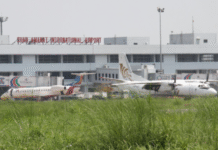Still far lower than govt’s 7.4pc target this fiscal year

Bangladesh’s gross domestic product (GDP) may grow by as high as 5.6 per cent in the current fiscal year, subject to three factors, said the World Bank yesterday.
This includes how the ongoing vaccination campaign fares, whether new restrictions to mobility are required, and how quickly the world economy recovers, it projected in its twice-a-year-regional update.
 For all latest news, follow The Daily Star’s Google News channel.
For all latest news, follow The Daily Star’s Google News channel.
“In Bangladesh, GDP is expected to increase by 3.6 per cent in FY21. However, significant uncertainty surrounds both epidemiology and policy development,” said the “South Asia Economic Focus South Asia Vaccinates” report.
“Thus, growth in FY21 could range from 2.6 per cent to 5.6 per cent,” it said.
Over the medium term, growth is projected to stabilise within a 5 to 7 per cent range as exports and consumption continue to recover.
South Asia’s prospects for an economic rebound are firming up as growth is set to increase by 7.2 per cent in 2021 and 4.4 per cent in 2022, said the report.
This means it will be climbing from historic lows in 2020, putting the region on a path to recovery.
“But the growth is uneven, and economic activity well below pre-Covid-19 estimates.”
It is a result of many businesses needing to make up for lost revenue, and millions of workers, mostly in the informal sector, are still reeling from job losses, falling incomes, worsening inequalities and human capital deficits. The report showed that the region was set to regain its historical growth rate by 2022.
Electricity consumption and mobility data bear clear indications of recovering economic activity.
India, which comprises the bulk of the region’s economy, is expected to grow more than 10 per cent in fiscal 2021-22, a substantial upward revision by 4.7 percentage points from January 2021 forecasts.
The outlook for Nepal and Pakistan has also been revised upward, supported by better than expected remittance inflows.
Nepal’s GDP is projected to grow by 2.7 per cent in fiscal 2021-22 and recover to 5.1 per cent by 2023. Pakistan’s economy is expected to expand by 1.3 per cent in 2021, slightly above previous projections.
The improved economic outlook reflects efforts of South Asian countries to keep their Covid-19 caseloads under control and swiftly roll out vaccine campaigns.
Government decisions to transition from widespread lockdowns to more targeted interventions, accommodating monetary policies and fiscal stimulus – through targeted cash transfers and employment compensation programmes – have also propped up recovery, the report noted.
“We are encouraged to see clear signs of an economic rebound in South Asia, but the pandemic is not yet under control, and the recovery remains fragile, calling for vigilance,” said Hartwig Schafer, World Bank South Asia vice president, in a press release.
“Going forward, South Asian countries need to ramp up their vaccination programmes and invest their scarce resources wisely to set a foundation for a more inclusive and resilient future.”
While laying bare the region’s deep-seated inequalities and vulnerabilities, the pandemic provides an opportunity to chart a path toward a more equitable and robust recovery, the WB said.
To that end, the report recommended that governments develop universal social insurance to protect informal workers, increase regional cooperation and lift customs restrictions on key staples to prevent sudden spikes in food prices.
South Asia, which grapples with high stunting rates among children and accounts for more than half of the world’s student dropouts due to Covid-19, needs to ramp up investments in human capital to help new generations grow up healthy and become productive workers.
Noting that the region’s public spending on healthcare is the lowest in the world, the report also suggests that countries further invest in preventive care, finance health research, and scale up their health infrastructure, including for mass and quick production of vaccines.
In a virtual press conference on Tuesday evening, WB South Asia Chief Economist Hans Timmer said vaccinations had started. But obviously, it was far from complete, and the dangers were still there.
There is a concern about the lack of investment. Bangladesh also lacks international investments into the economy, he said.
“We have also seen in Bangladesh a rebound of activity in the last two quarters, and that was positive news. But that doesn’t mean it will be sustained easily,” said Timmer.
“At the same time, we should not forget that there are also strong forces for recovery,” he said
“We think in the long run the growth potential of Bangladesh is between 5 and 7 per cent, so ultimately the economy will return to that. But before that, you have to also undo the damage that was done. So, there is a tough road ahead,” he said.
World Bank’s new GDP growth prediction for Bangladesh is still far lower than the government’s estimate of 7.4 per cent for the current fiscal year.
The lender is now estimating growth of 2.4 per cent for the last fiscal year, while the government’s provisional estimate showed the GDP had grown by 5.24 per cent.
In reply to a query about such a difference, Timmer said it was indeed an indication that uncertainty was very high at the moment.
“I think it is not illogical that you see those differences because uncertainty is really high, and it depends on the kind of assumptions that you are making,” he said.
“On last year’s estimate of growth, my understanding is that from Bangladeshi side, it is still an estimate; it is not a final number,” he said.
In this regard, Finance Minister AHM Mustafa Kamal yesterday said, “They (World Bank and other organisations) project something. But they accept the GDP data that we make finally.”
“They only check whether our methodology was correct or not. And it has been happening for the last 10 or 12 years,” he told a virtual briefing following a meeting of the cabinet committee on purchase.
Claiming that the Covid situation is still under control and would be in control, the minister hoped that it would not affect the economy much.
He, however, said, “As we are engaged with the global economy, if our buyers are hit economically, it may also harm our economy because the government has no control over the global situation.”
All the countries are carrying out vaccinations, and with its completion, the impact of Covid-19 will come down, he hoped.
WB REPORT ON BANGLADESH
Following a sharp GDP growth deceleration in FY20 due to the pandemic, the economy started recovering in the first half of FY21, as movement restrictions were lifted and international buyers reinstated export orders.
Going forward, a gradual recovery is expected to continue, particularly if the government’s Covid-19 recovery programmes are implemented swiftly.
With growth firming up, poverty is projected to decline marginally in FY21.
The pandemic impacted the economy profoundly. A national shutdown from March to May last year resulted in severe supply-side disruptions in all sectors of the economy.
The government’s Covid-19 stimulus provided firms with access to working capital and low-cost loans to sustain operations and maintain employee wages in FY20 and FY21.
From June onward, movement restrictions have been progressively lifted, and transit and workplace movement patterns returned to pre-pandemic levels by October.
According to the report, the downside risks are likely to persist if new waves of Covid-19 re-emerge in Bangladesh or its trading partner countries.
“This could necessitate additional movement restrictions, dampen demand for readymade garment, and/or limit the outflow of migrant workers.”
Bangladesh’s expected graduation from the UN’s least-developed country status in coming years will present opportunities but also challenges, including the eventual loss of preferential access to advanced economy markets, the report said.
Estimated poverty rose sharply in the fiscal year 2019-20 amidst substantial job and income losses.
However, household surveys point to a gradual recovery in employment and earnings and a decline in poverty in the first half of the fiscal year 2020-21.
Food security improved across the country, with the most significant increase in Chattogram.
The report stated that risks to the outlook might persist.
It identified fiscal risks, including weak domestic revenue growth (if tax reforms are delayed) and higher expenditure for Covid-19 vaccination (if external financing is limited) and for supporting the Rohingya refugees (if donor fatigue sets in).
In the financial sector, contingent liabilities from non-performing loans combined with weak capital buffers could necessitate recapitalisation (resulting in higher domestic government debt) and depress credit growth.
External risks could also be elevated.
While external demand for RMG appears to be stabilising, the recovery is fragile and could be vulnerable to new waves of Covid-29 infections.
Demand for Bangladesh’s overseas workforce in the Gulf region may also be impacted by the ongoing recession in that region, impairing future remittance inflows.









